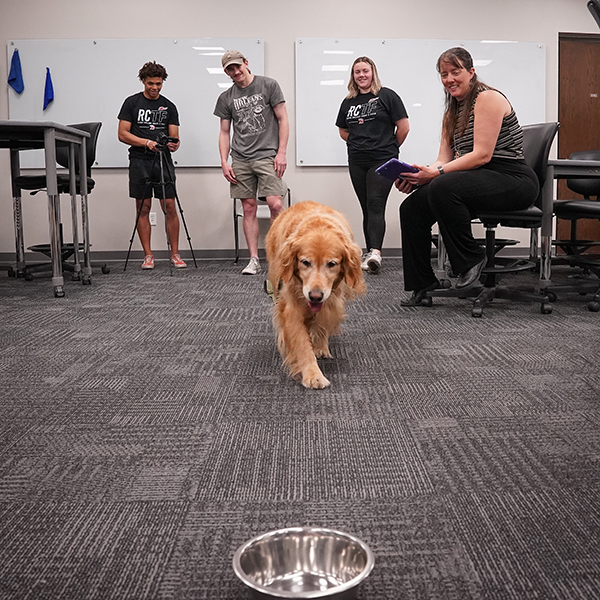Dog empathy research is rapidly expanding our understanding of the profound connections between canines and humans. At the forefront of this fascinating field are researchers like Erin Hecht from Harvard, who delves into the canine brain science that underpins dog behavior and empathy. As the human-canine bond grows stronger, studies reveal how dogs are not only responsive to our emotions but also exhibit remarkable empathy. Innovations in imaging techniques, such as MRIs, allow scientists to explore the complexities of dog emotions and responses, providing valuable insights into their behavior. The insights gained from these Harvard dog studies have far-reaching implications for both pet owners and the wider understanding of animal behavior.
Exploring the intricacies of canine empathy offers a unique glimpse into the emotional lives of dogs and their interactions with humans. Recent inquiries into the social cognition of dogs reveal how these furry companions can sense human feelings and respond accordingly, shedding light on their empathetic behaviors. By examining the archaeological and evolutionary aspects of dogs as social partners, researchers are uncovering the cognitive capabilities that have been honed through generations. The interplay between our emotions and those of our pets fosters a distinct relationship, which is further documented through engaging platforms like The Dogist photography. This growing body of dog behavior research not only highlights the loyalty and affection our canine friends provide but also emphasizes the importance of understanding their mental and emotional landscapes.
Exploring Canine Brain Science: Insights from Harvard’s Research
At the forefront of canine brain science, Harvard researcher Erin Hecht has been pioneering studies that delve into the cognitive processes of dogs. Using advanced MRI technology, Hecht’s lab investigates how dogs think and feel, shedding light on their emotional responses and thought patterns. This research addresses fundamental questions surrounding dog behavior and cognition, illuminating the remarkable complexity of the canine mind. By observing neural activity in response to various stimuli, scientists are gradually piecing together the intricacies of how dogs interpret their surroundings, form attachments, and even express empathy.
Moreover, Hecht’s findings are grounded in empirical evidence that challenges common misconceptions about canine intelligence. For instance, her research indicates not just instinctual reactions but also learned behaviors that contribute to heightened social awareness among dogs. Recent studies from Harvard highlight the significant correlations between a dog’s brain structure and its behavioral tendencies, reinforcing the idea that understanding our pets on a scientific level can enrich our own human-canine bond.
The Human-Canine Bond: A Profound Connection
The relationship between humans and dogs has transcended centuries, evolving into a partnership characterized by mutual trust and affection. This deep connection is evident in the work of photographer Elias Weiss Friedman, known for his Instagram account ‘The Dogist,’ where he captures the essence of dogs through candid photography. Friedman emphasizes how dogs serve as social catalysts that connect individuals and foster community engagement. From local parks to city streets, the presence of a dog can break down social barriers, encouraging conversations that might otherwise never happen.
Friedman’s work not only showcases the beauty of dogs but also underscores the intrinsic value of the human-canine bond. Each photograph tells a unique story that highlights the emotional depth and diversity of dogs’ personalities. This portrayal mirrors Hecht’s investigations into how dogs interpret human emotions and reactions, demonstrating that these animals not only cohabit our worlds but also share in our experiences, making their emotional intelligence a vital part of our lives.
Empathy in Dogs: Behavioral Studies and Observations
One of the most intriguing aspects of dog behavior research is their ability to empathize with human emotions. Hecht’s studies provide evidence that dogs possess an innate capacity for empathy, responding to their owners’ emotional states with remarkable sensitivity. During behavioral assessments at Harvard’s Canine Brains Lab, dogs have shown specific reactions to simulated distress scenarios, such as approaching their handlers and providing comfort through physical connection, which showcases their understanding of human feelings.
Friedman’s photographic documentation captures these empathetic responses in real-time, serving as visual proof of dogs’ emotional intelligence. Observing a dog’s compassionate actions towards a person in distress highlights the significance of empathy as an evolved trait that enhances the bond between dogs and humans. This research not only validates the profound connections individuals share with their pets but also emphasizes the wider implications of such behaviors within human society, encouraging a deeper appreciation for the empathy that dogs exhibit.
Cognitive Styles and Behavioral Diversity in Canines
Research has revealed varying cognitive styles among different dog breeds, illustrating the fascinating relationships between a dog’s historical functions and their current behavioral attributes. Hecht’s multifaceted studies explore the breadth of intelligence present in dogs, affected by factors such as breed, upbringing, and environment. By categorizing dogs based on their cognitive abilities, researchers can better understand how these traits manifest in everyday behavior and interactions with humans.
This understanding also aids in addressing behavioral issues, particularly those stemming from early-life trauma or stress. Hecht’s lab places great emphasis on recruiting dogs with such backgrounds for research purposes, as these studies can reveal the lasting impacts of early experiences on canine behavior. By learning about the cognitive differences among dogs, trainers and owners can tailor their approaches to meet each dog’s unique needs, enhancing their training and nurturing processes.
The Role of Photography in Understanding Dog Behavior
Any discussion of dogs and their relationship with humans would be incomplete without acknowledging the role of photography in shaping public perceptions. Elias Weiss Friedman’s project, ‘The Dogist,’ illustrates how visual storytelling can deepen our understanding of dog behavior and personality. Through the lens of his camera, Friedman captures candid moments that reveal dogs’ true expressions, reflecting their moods and emotions naturally.
Friedman notes that photographing dogs gives a glimpse into their world, allowing viewers to appreciate their authenticity and individuality. This connection between photography and dog behavior research serves a dual purpose: it educates the public about canine emotion and promotes a stronger empathetic relationship between humans and their pets. The imagery not only showcases the joy dogs bring to our lives but also encourages a greater awareness of their emotional needs and social behaviors.
Engaging Communities Through Canine Companions
In addition to enhancing individual relationships, dogs serve as a bridge that fosters broader community engagement. As Friedman describes, the simple act of walking a dog becomes a communal activity, transforming neighborhoods into social hubs where people meet and interact. This phenomenon illustrates how dogs enhance our lives by encouraging social connections and promoting interactions that might not occur otherwise.
Furthermore, research indicates that dogs can significantly reduce feelings of loneliness and improve mental health outcomes for their owners. By studying the dynamics of how dogs interact with humans in various contexts, researchers can better understand the societal roles that these animals play. Within community settings, initiatives that bring dog owners together can help cultivate friendships, create support systems, and enhance the overall quality of life for both humans and dogs.
Dogs as Both Subjects and Symbols in Scientific Inquiry
In the scientific realm, dogs are both subjects of study and symbols of the profound connections we share with animals. Hecht’s research into canine brains provides critical insights into the complexities of dog behavior, revealing why they are often seen as ideal companions and social partners. This dual role underscores the importance of studying our canine companions not just from a biological perspective but also from an emotional and social standpoint.
As research continues to evolve, so too does our understanding of dogs as complex beings capable of forming intricate relationships with humans. The insights garnered from both scientific examination and artistic representation, such as in Friedman’s photography, reflect an era of re-evaluation of the human-canine bond and its implications for both species. This comprehensive approach fosters a greater appreciation for dogs, ensuring they are valued not only for their companionship but also for their intelligence and unique contributions to society.
The Future of Canine Research and its Impact on Humanity
The future of canine research is poised to yield exciting discoveries that could transform our understanding of dogs and enhance our relationships with them. Researchers like Erin Hecht are at the forefront, exploring uncharted territories in canine cognition and behavior, which hold implications not just for dog owners but for the broader fields of animal science and psychology. This ongoing research may lead to better training methods, improved welfare practices, and deeper insights into canine health—key components that can dramatically improve the lives of our furry companions.
As this field continues to grow, it also invites collaboration across disciplines, merging science with art—evident in the work of photographers like Friedman who document the emotional lives of dogs. This interdisciplinary approach could foster a better public understanding of canine needs and behaviors, resulting in policies that advocate for animal welfare. Ultimately, this research endeavors to enhance the bonds that exist between us, promoting a shared understanding of what it means to coexist with dogs in a compassionate and informed manner.
Frequently Asked Questions
What does dog empathy research involve in the context of canine brain science?
Dog empathy research focuses on understanding how dogs respond to human emotions and situations, utilizing techniques such as MRIs to explore their brain activity. By studying canine brain science, researchers like Erin Hecht delve into dogs’ emotional responses, revealing their capacity for empathy and understanding of human feelings.
How do Harvard dog studies contribute to our knowledge of the human-canine bond?
Harvard dog studies, particularly those conducted by researchers like Erin Hecht, explore the underlying neurological aspects of the human-canine bond. These studies reveal how dogs have evolved to connect with humans on an emotional level, demonstrating empathy and social interaction skills that strengthen our companionship.
What role does dog behavior research play in measuring canine empathy?
Dog behavior research examines how dogs react to various emotional stimuli, providing insights into their empathetic abilities. This research, often paired with brain imaging techniques, helps scientists understand the complexities of canine emotions and how they align with human emotional cues.
Why is The Dogist’s photography significant in the study of dog empathy?
Elias Weiss Friedman, known as The Dogist, uses photography to capture genuine moments of canine expression, highlighting their emotional range. His work complements dog empathy research by visually documenting the emotional connections dogs share with humans, making the study of their empathy more relatable and engaging.
How does understanding dog empathy enhance the human-canine relationship?
Understanding dog empathy enhances the human-canine relationship by fostering deeper connections based on emotional intelligence. Research into canine brain science and empathy allows owners to appreciate their dogs’ responses, creating more meaningful interactions and improving overall well-being for both dogs and humans.
What are some behavioral indicators of empathy in dogs according to canine behavior research?
Canine behavior research has identified several indicators of empathy in dogs, such as their responsiveness to human emotional expressions, comfort-seeking behaviors, and the way they approach distressed individuals. These behaviors underline dogs’ innate ability to sense and respond to their human companions’ feelings.
What insights can we gain from Harvard dog studies regarding the evolution of canine empathy?
Harvard dog studies provide insights into how dogs have evolved alongside humans to develop social cognition and empathetic behaviors. By examining the genetic and neurological factors that influence their emotions, researchers can trace the development of empathy as a vital trait in fostering the human-canine bond.
How do canine brain science findings impact our understanding of dog training and behavior modification?
Findings from canine brain science impact dog training and behavior modification by highlighting the importance of emotional awareness in dogs. Understanding their capacity for empathy helps trainers develop techniques that harness dogs’ emotional responses, leading to more effective training approaches and improved behavioral outcomes.
| Key Points | Details |
|---|---|
| Dog Empathy Research | Harvard researchers study dogs’ reactions and empathy using experimental methods. |
| Canine Brains Project | Erin Hecht uses MRI scans to investigate the inner workings of dog brains, exploring emotions and cognitive capacity. |
| Photographic Insights | Elias Weiss Friedman captures authentic dog expressions, highlighting their candid nature and emotional honesty. |
| Community Engagement | Dogs serve as social connectors for people, fostering community and relationships among dog owners. |
| Behavioral Research | Research is conducted on dogs with behavioral issues and the bonding between children and their pets. |
| Photographic Influences | Friedman’s experiences with dogs have evolved from humor to a deeper understanding of the emotional complexities of dogs. |
Summary
Dog empathy research delves into understanding the emotional bonds between dogs and humans. The studies conducted at Harvard reveal fascinating insights about canine behavior and their capacity for empathy. Researchers like Erin Hecht and photographers like Elias Weiss Friedman leverage various methods to highlight the emotional intelligence of dogs and their ability to connect with humans in profound ways. Through MRI brain scans and candid photography, we are beginning to understand just how deep the empathy runs in our furry companions. This research is crucial for advancing our knowledge of dog behavior and enhancing our relationships with them.


